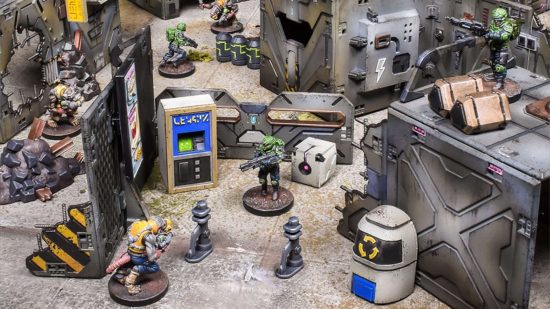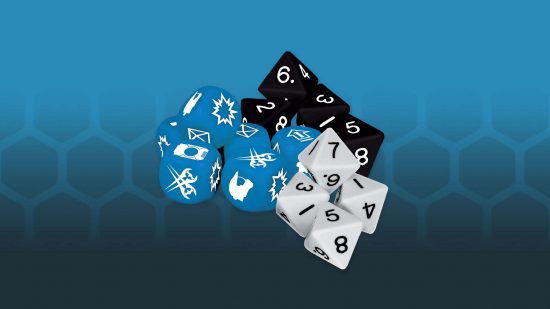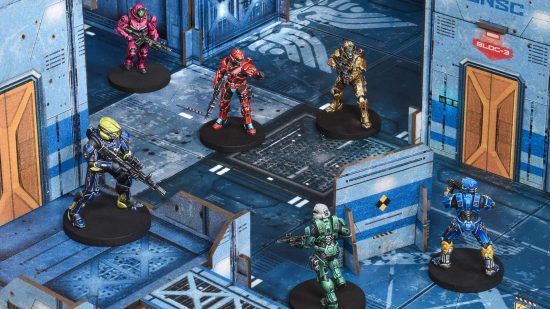Mantic Games has revealed that the Halo: Flashpoint rules will be an evolution of the system used in its existing sci-fi skirmish game Deadzone. If you’ve never played Deadzone before, or haven’t picked up a wargame at all, you might wonder what that means for the upcoming Halo release – so here’s everything you need to know.
We think Halo: Flashpoint has a good chance of being accessible for first time miniature wargamers, and quick and fun for established players, because of the core Deadzone rules it’s running on.
Wargamer has compared Deadzone to Warhammer 40k: Kill Team in the past: both are sci-fi skirmish games in which elite squads of commandos battle for objectives in a small, dense battlefield. But Deadzone is far more streamlined than Kill Team, as we found in our Deadzone third edition review.
These are the core rules of Deadzone, the basis of Halo: Flashpoint:
The board
Deadzone is fought across a 24” x 24” battlefield. The battlefield is divided into a grid of squares, which are used for measuring the distances that units can move or shoot. The grid extends up vertically too, and there’s a line of dedicated terrain that follows the same grid system.
This makes it very quick to spot which models are in range and which ones aren’t, without using tape measures, and there’s never any ambiguity about whether a model is or isn’t in range.
The objective of the game
Each round, players take it in turns to activate one model from their team. A model can usually perform two actions each turn, or one long action. Players vie for position with their models, blasting each other with guns or piling into them with melee weapons, over a series of rounds.
Both players are trying to score the most victory points before the mission ends. Each mission has its own victory conditions, for example controlling specific objective cubes on the board. You can also get points by taking out enemy operatives, and there’s a VP bounty for icing particularly strong enemy models.
Dice rolls
Deadzone uses eight sided dice to test whether models succeed at actions like shooting one another or fighting in melee. Players assemble a pool of three dice, and then need to roll equal to or over a particular stat value. Each model has its own unique stats, which make it better at some things and worse at others.
Rolls of eight ‘explode’, giving you an extra die to roll. You can keep doing this if you keep rolling eights, allowing for hail-mary shots and moments of pure luck – but for the most part, the dice are fairly predictable.
Deadzone also uses unique Command Dice, which get rolled at the start of each round. Each face on the Command Dice gives you a special, one-use ability for that round: for example, allowing you to activate two models in a row before your opponent takes a turn, giving a model a free shoot action, or using the team leader’s special action. They’re all simple and useful, but you never know which bonuses you’ll have access to each turn.
Combat
During combats, the attacker rolls to Fight or Shoot their enemy, and the defender rolls to Survive. If the attacker scores any net successes, they inflict that much damage, potentially killing their opponent if they can strip all their HP. Damage from attacks can be prevented by armor, which can in turn be negated by armor piercing weapons.
Attack bonuses
The rules assume that, as trained special operatives, both players’ units are always actively using cover. Instead of putting a penalty on shooting a unit that’s in cover, models receive a bonus for shooting a unit out in the open.
That bonus takes the form of an extra die on the shooting attack roll. There are other bonuses, such as shooting from an elevated position. Many weapons and units have keyword abilities. For example, a model with the Smash keyword gets extra dice on its melee attacks, while a model firing a gun with a Sniper Scope can give up one action for the turn to get +2 dice on their shoot roll.
The more bonuses you line up, the bigger the handful of dice you will roll when you attack. You never need to do any adding or subtracting when working out whether or not a roll is successful, and you never remove dice from a dice pool. Just build your dice pool, roll it, and compare each die against the relevant stat.
There’s plenty more variety in Deadzone, but it builds on this simple core. With a playing area that will fit onto a dining room table, small teams of miniatures, and a streamlined design that smooths off many of wargaming’s spiky edges, it’s a good entry point for videogame players who want to try a miniature wargame.
Halo: Flashpoint rules changes
Mantic has already confirmed that the grid battlefield, dice pools, bonuses for shooting models from an elevated position, and exploding eights will all make it from Deadzone into Halo: Flashpoint. There will also be some Halo specific rules, such as new rules for energy shields, respawn points, and missions based on multiplayer missions including Slayer, Oddball, and Capture the Flag.
Of course, there’s nothing stopping you from picking up Deadzone right now, rather than wait for Halo: Flashpoint to release this fall.
Dan Mapleston from Mantic’s marketing team told Wargamer that, even though a sister game is being released, Deadzone itself won’t be neglected, and more releases are planned for this year.

Make sure you check out the Halo: Flashpoint starter sets, as the miniatures are really impressive – we’ve seen them in person and they’re gorgeous. If you’d like a good sense of how Mantic has evolved as a company since it was founded fifteen years ago, and what quality of product it produces today, check out our backstage tour of Mantic Games.






